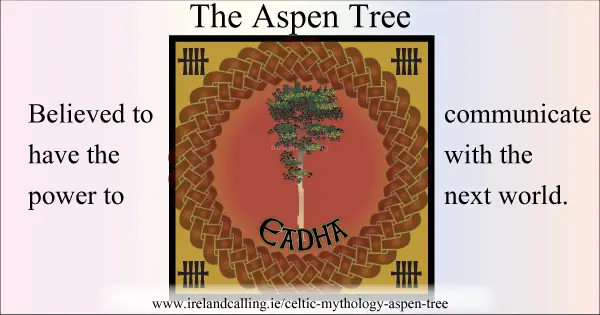The aspen – also known as poplar – was associated with language, communication, the wind, endurance and resurrection.
Crowns of aspen or poplar leaves have been found in ancient burial grounds thought to be there in order to aid the dead on their path to rebirth.
In Greek mythology, poplar leaves were worn by heroes venturing into the underworld. The leaves were thought to have the power to pass freely between the worlds.
The Greek name for aspen is ‘aspis’ which literally means shield. This association transferred over to Ireland where the aspen was known as the shield makers’ tree.
The Celts chose the lightweight wood of the aspen tree to make their shields which were thought to protect them from spiritual more than physical harm.
Communicating with the next world
The protective qualities of the aspen meant they were also often planted near dwellings.
Eadha, E
The Aspen is the Celtic tree of the autumn equinox. It is the nineteenth letter of the ogham alphabet ‘Eadha’.
The Latin name for aspen is ‘populus tremula’ meaning trembling poplar because the leaves of the aspen appear to tremble in the wind. In Celtic mythology this visual effect was said to be the tree communicating between this world and the next.
The quivering leaves helped the wind speak with the ancestors while also bearing gifts of inspiration and poetry. For these reasons the aspen was sometimes known as the whispering tree, a sacred tree to the Celts.
In Scotland, as a fairy tree, the aspen had taboos similar to the extremely sacred rowan tree. To cut one down was akin to killing your fellow man.
Christians said the tree was ‘evil’
The Christians, in their opposition to the old pagan ways, had a tendency to change any sacred tree’s reputation from magical to evil. So, like several other trees, the aspen was said to have provided the wood for the cross at the crucifixion.
Its trembling leaves were the result of the tree shuddering in shame at the memory of this. So feared and hated the aspen became that even up to recent times people could be seen throwing stones at the poor tree!
Due to its religious and mythological reputations, good and bad, the aspen had few practical uses throughout history. It was said to be used as a coffin maker’s measuring rod.
However this is believed to be more for spiritual reasons than practical due to the tree’s association with resurrection and communication with the dead. It was thought that the rod assured the dead this was not the end.
Most of the practical uses for the wood of the aspen are quite modern. It is used for making paper and matches due to its low flammability and when heat treated it is an effective sauna interior.
Crowns of aspen or poplar leaves have been found in ancient burial grounds thought to be there in order to aid the dead on their path to rebirth.
